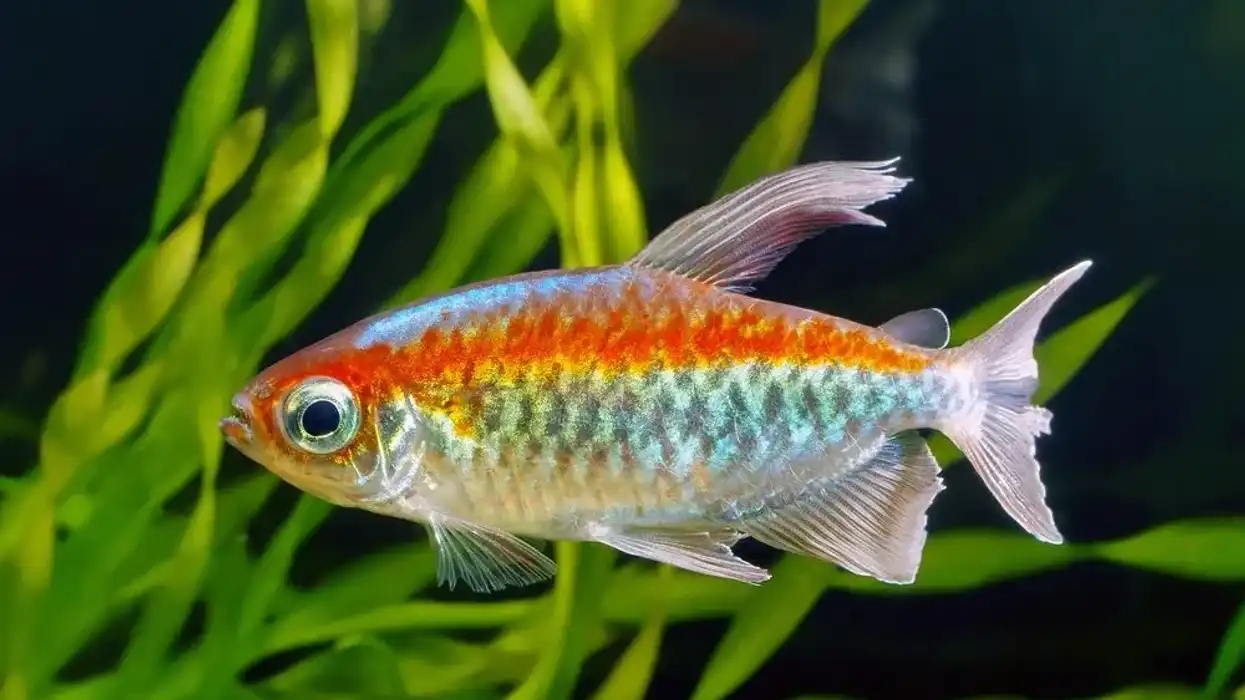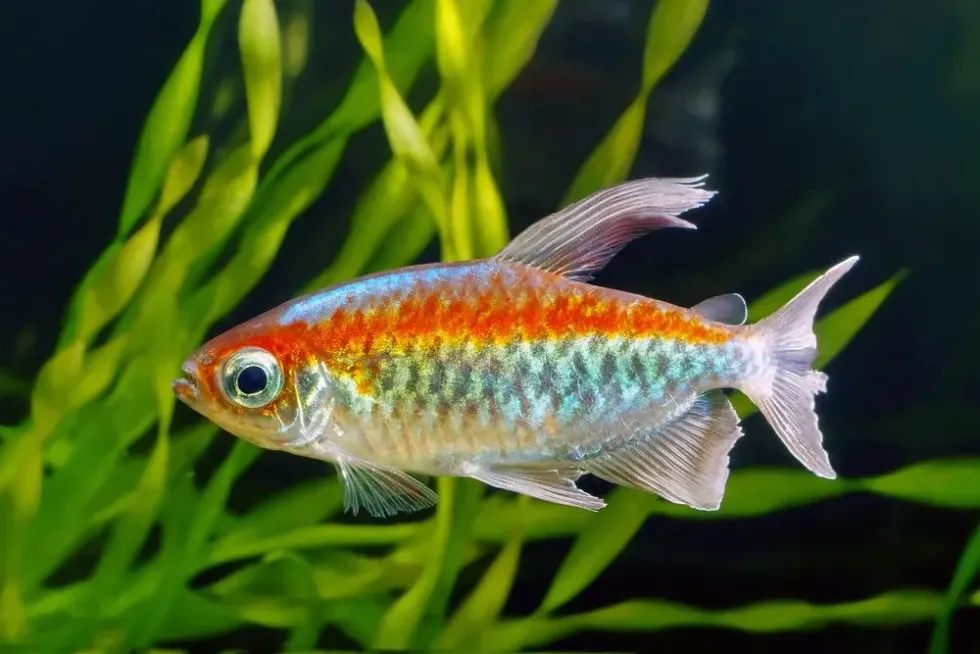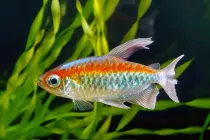Fun Congo Tetra Facts For Kids

Content
- What type of animal is a Congo tetra?
- What class of animal does a Congo tetra belong to?
- How many Congo tetras are there in the world?
- Where does a Congo tetra live?
- What is a Congo tetra's habitat?
- Who do Congo tetras live with?
- How long does a Congo tetra live?
- How do they reproduce?
- What is their conservation status?
- What do Congo tetras look like?
- How cute are they?
- How do they communicate?
- How big is a Congo tetra?
- How fast can a Congo tetra swim?
- How much does a Congo tetra weigh?
- What are their male and female names of the species?
- What would you call a baby Congo tetra?
- What do they eat?
- Are they eaten by humans?
- Would they make a good pet?
- Did you know...
- What is a Congo tetra's coloring used for?
- How to tell the difference between male and female Congo tetras?
The South American colorful tetras have their old world relative species distributed in the freshwater rivers of Africa. They are equally colorful and give off an amazing shimmer in the water.
One such extremely beautiful counterpart is the Congo tetra that glows in all the colors of the rainbow. The Congo tetra is a fairly hardy and strong species but only if they are kept in their natural habitat.
This is true even for their captive habitats. They hover in schools or groups over a dark substrate made up of silt, mud, and sand.
A Congo tetra cannot be typically considered a long-lasting fish. These omnivores include both animals and plant matter in their diet.
There are certain water parameters that need to be followed if you plan to keep this fish as your pet. For example, the water quality should be slightly acidic and the water hardness should be between 1.5-3 dH.
They require large swimming space so the tank size must be over 30 gallons. For more information about the species, continue reading some interesting facts about Congo tetras that are given below.
Check out spiny dogfish and black marlin facts too for similar content.
Congo Tetra Interesting Facts
What type of animal is a Congo tetra?
The extremely beautiful fish called Congo tetra (Phenacogrammus interruptus) occur widely in the African Congo River basin and therefore get their name from their native waters. This popular tank or aquarium fish is a piece of cake to deal with for all aquarists.
What class of animal does a Congo tetra belong to?
Congo tetras (Phenacogrammus interruptus) of the Congo river are bony fish of order Characiformes that belong to the class Actinopterygii or the class of all bony fish.
How many Congo tetras are there in the world?
Congo tetras (Phenacogrammus interruptus) are freshwater fish that can also adapt very easily in an aquarium. These beautiful fish are commercially bred in their native regions and the counterparts are sold in countries of Europe and many other eastern countries.
As a result, tracking their accurate number and determining their population becomes very difficult.
However, it is believed that the Congo tetra population is not yet threatened and they are found in large numbers as pet fish in a household aquarium or tank all over the world.
In an aquarium, they are always found in groups or schools as living alone causes stress to the fish and even leads to death. An aquarium Congo tetra group should contain at least six fish of the same species.
Where does a Congo tetra live?
Congo tetras are an Old World fish of the American tetra family that has originated in the upper reaches of the Congo River in Zaire.
In the wild, they are endemic fish of the entire Congo River drainage system of the Democratic Republic of Congo.
The yellowtail Congo tetra range covers both the Republic of Congo as well the Democratic Republic of Congo while the longfin Congo tetra extends from The Gambia to the Democratic Republic of Congo.
The red Congo tetra is found in many freshwater regions of Africa apart from the Congo basin like Liberia's Nipoué River, Tanzania's Wami River, lower Zambezi, Pongolo in South Africa, and Lake Malawa.
Many breeds are commercially traded to the eastern tropical countries like the beautiful albino Congo tetra that has an African origin but is found in Indonesia.
What is a Congo tetra's habitat?
Congo tetras are freshwater fish that populate the Congo river basin of Africa. The different Congo tetra species occur in different parts of the basin.
A Congo tetra in an aquarium or tank can live a healthy life only if its captive habitat imitates its habitat in the wild. These fish inhabit the dark and murky water streams, pools, tributaries, and marshes.
The preferred water quality of Congo tetras has certain specifications. They stay in slightly acidic water pools having minimum water hardness and mid-range water temperature.
The optimum pH level and water temperature range for Congo tetra survival are 6.2 and 75-81 degrees Fahrenheit respectively.
Similar or more or less imitating water conditions should also be maintained for pet fishes in their aquarium or tank. These fish crowd more in the water area where dense and tall vegetation is common with few trees.
Keeping a layer of sandy and muddy substrate at the bottom of the aquarium or tank containing this fish is recommended. To maintain their health, they need a large and free swimming space for uninterrupted swimming and fresh and peat filtered water conditions.
The ideal Congo tetra tank size should not be less than 30 gallons. These slow water species prefer to stay in dark water covered with dense vegetation in the wild or in a low-light aquarium with floating plants in captivity.
Who do Congo tetras live with?
The Congo tetra (Phenacogrammus interruptus) is a well-known species of schooling fish. It is necessary to keep them in a school containing a minimum of six to eight other Congo tetras.
They can get stressed and anxious if they do not live with a group of the same species. Apart from that, they can also stay peacefully with other fish that are smaller in size than them. Some famous Congo tetra tank mates include corydoras, dwarf cichlids, rainbow fish, and their other relative tetra fish.
In an aquarium, a Congo tetra might get bullied because of their peaceful nature by other larger aggressive fish species. So it is better to avoid them.
How long does a Congo tetra live?
The Congo tetra lifespan is short and generally, they stay alive only for three to five years, that too in captivity. On very rare occasions aquarists have seen this fish crossing five years.
The only way of ensuring the maximum longevity of these fish is by providing them with a healthy environment and maintaining the specific water conditions required for them. It is also important to follow a proper diet for these fish as they are prone to get stressed if they do not consume their usual diet.
How do they reproduce?
The shimmery large scales of a Congo tetra (Phenacogrammus interruptus) play an important role in the courtship behavior of this fish. Both males and females display their glowing colors to attract each other for the purpose of breeding.
A female fish is capable of laying at least 300 eggs and all of them are likely to hatch if adequate water parameters are maintained.
Congo tetra breeding occurs in the morning, in presence of light. The breeding pair is kept in a separate breeding tank right before sunset.
The spawning starts the following morning.
Keeping the pair together in darkness for a minimum of eight hours is necessary for congo tetra fish. The male performs a little dance where they show off their extravagant colored scales and fins to the female.
If the female is receptive then she leads the male into the moss present on the substrate and in artificial setups, at the bottom of the breeding aquarium or tank.
The females lay their eggs in a diving position at the breeding location itself and the eggs fall over the moss-laid substrate, protecting a large number of eggs from hitting the ground directly. The water conditions should be maintained even in the breeding tank with a temperature of 81 degrees Fahrenheit.
Congo tetra fish can eat their own eggs and for this reason, they must be taken out of the tanks and put in their original aquarium with other fish as soon as breeding and spawning are over, to protect the eggs.
The Congo tetra eggs hatch after five to eight days. Other tetra species eggs hatch much faster than the Congo tetra eggs.
What is their conservation status?
Congo tetras are listed as a species of Least Concern in the IUCN Red List. These schooling fish occur aplenty in the Congo Basin and therefore do not face any fear of extinction in the near future. They are found commonly in aquariums all over the world.
Congo Tetra Fun Facts
What do Congo tetras look like?
A Congo tetra has a slim and torpedo-shaped slender body. They have a very unique appearance which makes them stand out in a crowd.
The adult fish flaunts different iridescent scales starting from the front till the back, up to the fins. The scale colors in Congo tetras start with blue on top that gradually transforms to a reddish color towards the middle to yellow gold and again finally changes to blue.
Congo tetra undoubtedly shows some excellent and extravagant scale colors but it is their fins that make them so unique. The fins of a male fish are more appealing than the female fins.
The males have long fins that look transparent and flows beautifully in the water. The dorsal fin is larger in males than in females.
The tail fin gives off a grayish purple hue with white shimmery borders on the edges. The reflection of light on their body gives them a rainbow appearance.

How cute are they?
A Congo tetra is not only cute but its unique colors make them one of the most attractive pet fish in the world. They are also good-natured fish and stay peacefully with others in an aquarium.
How do they communicate?
Like all other fishes, they communicate by using sound and electrical impulses. Communication helps in navigation in the water as well as during breeding.
How big is a Congo tetra?
Although Congo tetras look long and elongated because of their slender body, they do not grow too long. The adult size of a male fish is around 3 in (8.5 cm) and that of a female fish is 2.8 in (6 cm). Their adult size is quite similar to the size of a peacock gudgeon.
How fast can a Congo tetra swim?
Congo tetras are a great fan of swimming and must be kept in areas having large swimming spaces. As fast swimmers, they should be kept with other fast swimming fishes so that everyone can consume the food that is provided in the aquarium. However, there is no information about the range of their speed.
How much does a Congo tetra weigh?
Congo tetras are very light and small fish and they weigh only around 3.5 oz (0.1 kg).
What are their male and female names of the species?
The male and female Congo tetra do not have any specific name for them. Both of them are collectively known as Congo tetras.
What would you call a baby Congo tetra?
Like all baby fish, a baby Congo tetra is called a fry.
What do they eat?
This fish species is very adjusting and are not at all picky eaters. They are omnivorous in nature and mainly feed on live plants and live foods. The live plants in a Congo tetra's diet include any kind of microscopic plant matter found on the substrate like algae, or zooplankton.
In the wild, they also eat small worms, crustaceans, and insects. The fish species diet in captivity mainly consists of high-quality flake food.
Treating them by including baby brine shrimp, bloodworms, or daphnia in their diet can be practiced once in a while. These fish can be fed multiple times in a day. They sometimes tend to shy away when the food is served.
Are they eaten by humans?
Congo tetras are aquarium fish and are not eaten by humans. Human beings are rather attracted to their beauty and consider them as a good pet option for their aquariums.
Would they make a good pet?
These fish make wonderful pets. They are not at all aggressive and do not have the habit of fin nipping with their teeth like neon tetras. An ideal congo tetra aquarium should contain fish species of similar size or fish that are smaller than them. A school of Congo tetras keeps the aquarium environment lively and joyous.
Did you know...
A Congo tetra gets the first part of its name from its native water and the second part from its tetra-shaped body.
What is a Congo tetra's coloring used for?
A Congo tetra gets its multiple neon body colors due to the light transfer mechanisms of its chromatophores. Not only humans but the males and females of the same species are also attracted to this fluorescent body of the fish.
A Congo tetra displays its colors to the other gender when they are interested in mating. So the coloring is used for courtship calls. The male fish also indulges in dances by showing off its color to attract a female to mate with it.
How to tell the difference between male and female Congo tetras?
Congo tetras exhibit sexual dimorphism. The Congo tetra size differs in males and females. The male fish is slightly larger than a female.
When a female gets ready to mate they look a bit rounder or plumper. The male fish are more brightly colored and they look more attractive.
They have a long and nicely defined, more flowy dorsal fin than the females. The tail fin is also a bit extended in the males. The females are duller looking as compared to the males and their stomach swells when carrying eggs.
Here at Kidadl, we have carefully created lots of interesting family-friendly animal facts for everyone to discover! Learn more about some other fish including barb, or lungfish.
You can even occupy yourself at home by drawing one on our goldfish coloring pages.
We Want Your Photos!
More for You
See All
Bachelor of Arts specializing in Journalism and Mass Communication, Postgraduate Diploma in Sports Management

Moumita DuttaBachelor of Arts specializing in Journalism and Mass Communication, Postgraduate Diploma in Sports Management
A content writer and editor with a passion for sports, Moumita has honed her skills in producing compelling match reports and stories about sporting heroes. She holds a degree in Journalism and Mass Communication from the Indian Institute of Social Welfare and Business Management, Calcutta University, alongside a postgraduate diploma in Sports Management.
Bachelor of Science specializing in Computer Science

Chandan ShuklaBachelor of Science specializing in Computer Science
With a Bachelor's degree in Computer Science from Aryabhatta College, University of Delhi, Chandan is a skilled and passionate technophile. He has completed a machine learning training program and is adept in various programming languages. He has been working as a content writer for two years while also striving to become a proficient tech professional.
Disclaimer
1) Kidadl is independent and to make our service free to you the reader we are supported by advertising. We hope you love our recommendations for products and services! What we suggest is selected independently by the Kidadl team. If you purchase using the Buy Now button we may earn a small commission. This does not influence our choices. Prices are correct and items are available at the time the article was published but we cannot guarantee that on the time of reading. Please note that Kidadl is a participant in the Amazon Services LLC Associates Program, an affiliate advertising program designed to provide a means for sites to earn advertising fees by advertising and linking to Amazon. We also link to other websites, but are not responsible for their content.
2) At Kidadl, we strive to recommend the very best activities and events. We will always aim to give you accurate information at the date of publication - however, information does change, so it’s important you do your own research, double-check and make the decision that is right for your family. We recognise that not all activities and ideas are appropriate for all children and families or in all circumstances. Our recommended activities are based on age but these are a guide. We recommend that these ideas are used as inspiration, that ideas are undertaken with appropriate adult supervision, and that each adult uses their own discretion and knowledge of their children to consider the safety and suitability. Kidadl cannot accept liability for the execution of these ideas, and parental supervision is advised at all times, as safety is paramount. Anyone using the information provided by Kidadl does so at their own risk and we can not accept liability if things go wrong.
3) Because we are an educational resource, we have quotes and facts about a range of historical and modern figures. We do not endorse the actions of or rhetoric of all the people included in these collections, but we think they are important for growing minds to learn about under the guidance of parents or guardians.







